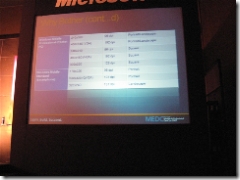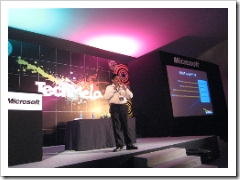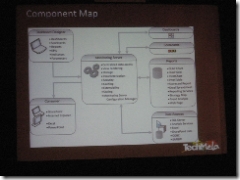Microsoft Performance Point Server (PPS) by Abhishek Srivatsa (Microsoft India):
I had little understanding on this product, so decided to start with this. The session gave me some overview on the product and on how it helps to collect and model data with its built-in tools. It uses SQL Server 2005 Enterprise for its own Meta-Data and Cubes, but the actual data can come from any source (RDBMS). End users can enter data easily through Excel and don’t need InfoPath (it is not supported now). PPS needs WSS or Sharepoint to run. Currently the workflow it uses is different but will be merged with WWF in coming releases. There is a RAD environment for doing Scorecards easily. The UI is Office 2007 like so better than the BSM UI. The presentor choosed not to show any demos and it all PPTs and I lived through it :-). I was told to go the afternoon session by one of the PMs of the product “Rohit” which I did.
REST with WCF by my good friend Janakiram MSV (Microsoft India): 
- He showed a demo of Weather.com XML and he commented on their URL having XOAP which he said could be for XML Object Access Protocol
- COAP (Complex Object Access Protocal) which Jani has coined which is for SOAP with all complexities of WSDL, etc. :-)
- He brought in good humour by calling all the assumed tenants of Web 2.0 – have a multi colour logo with reflection, rounded-edges, always is in Beta, register your domain with ‘r’ as suffix – flickr, twitter,etc.
- He talked about how bollywood is reinventing old movies like DON. Similarly how industry is reinventing CSV. He was drawing a parallen on JSON which was plain old CSV with some simple meta-data.
- He joked on how Microsoft has embraced extensively XML so that people may call it “eXtremely Microsoft Language” :-)
 Wired Format Protocols:
Wired Format Protocols:
- POX – Plain Old XML has no meta-data; SOAP has meta-data. POX comes with a catch, there is no contract, you get something from a server and you figure out the schema and hard-codes them.
- JSCON – Javascript Object Notation

- WCF in .NET 3.5 (Orcas)
- JSON/AJAX Support (WebHttpBinding, JSON Message Encoding)
- Syndication Support (RSS 2.0, ATOM 2.0)
- HTTP Programming Support (REST, POX)
- Data Contracts are object contracts that we can send over wires.
- He showed a good demo on Maps with Theatre mash-ups
- There is a good blog post by James Clarke on JSON vs XML
Extending Browser Object with Silverlight by Pandurang Nayak (Microsoft India)
- Though I have been to the same session on Silverlight in Mix ’07, I decided to be here because I haven’t been any of Pandurang’s session before.
Building Business Insights using Performance Point 2007 by Rohit Rahi (Microsoft Corp)
- May be b’cos he was from the product team, but this session was fabulous on its own and especially after the morning one I attended on PPS. The speaker had only 1 hour (Organizers: You need at least 75-90 minutes for a decent tech talk with demos) and he did a fantastic job of it – skipping all PPTs, showing only demos and took taking plenty of questions patiently even on licensing which he had no control on :-)
- You can download the current CTP2 as a complete VPC with Server and Client preinstalled and ready to play with. Lot more features are coming in CTP3 in few weeks. The final release is getting shipped by end of this year.
- When you buy PPS v1.0 you will also get Proclarity 6.3 free – so you can both servers. In next version of PPS lot more features of Proclarity will be introduced, currently almost all Proclarity web features are in PPS v1.0
- What is ScoreCard – it is a sweet spot between Reporting and Analytics
- In PPS now you can easily create dashboard using an Office 2007 like UI client, and publish the entire dashboard in one click to MOSS without the cumbersome process of creating each webpart in MOSS. This client – Dashboard Designer is a huge
 improvement in PPS from BSM. You also have bulk editing capabilities, Analytic view designer, Time Intelligence. New data sources including SAP BW 3.5, Sharepoint Lists, Excel Services are introduced
improvement in PPS from BSM. You also have bulk editing capabilities, Analytic view designer, Time Intelligence. New data sources including SAP BW 3.5, Sharepoint Lists, Excel Services are introduced - BSM 2005 and Proclarity 6.3 users and applications can easily move to PPS v1.0 straight away.
- He demoed a cool Strategy Map which is a visual representation of Balanced Scorecard. Helps you to see how KPIs are related. You can also have your reports to linked to each KPIs. KPIs can be imported easily from your SQL Server Cubes or from Excel as well.
- Strategy Maps are actually Visio 2007 web part, so it can be easily a Plant Map or any other diagram in Visio 2007. Even Organization charts can be connected and shown how each is performing to their KPIs
- People confuse between Dashboard and Scorecard. There is no clear definition, but Microsoft likes to call Dashboard as an entire page which has one or more Scorecards and reports.
- PPS v1.0 supports parameterized Scorecards which can be used to see your scorecard for a selected value (Country, Price, etc.)

- Unlike in BSM where it was difficult to create scorecards since first you have to create KPIs; in PPS it is other way – create scorecard first and then KPIs
- PPS v1.0 is introduced some new web parts like OLAP Grids and OLAP Charts – these can be thought of as next version of Office Web Components
- Answering questions:
- Sharepoint and PPS – How do you compare them for dashboard functionality, since both provides dashboard capabilities and how do you rationalize the choice. Some you can do even with Excel Service. Rohit acknowledged it was a tough question and the overlap between products, which over versions will get ironed out
- Why should I buy CALs, when I already Sharepoint CALs and that too only to see the data?. Again Rohit acknowledged the problem, but highlighted how Microsoft PPS is still cheaper at $200 per CAL compared to Cognis and other competition at $4000 or so.
- Does it support versioning and archiving in scorecard. It seems “No” for right now, but BSM has it today.


Device Independent UI for Windows Mobile by Mel Sampat (Microsoft Corp) 
- There are tons of devices with different form factors with more coming in the months and so the UI should work well across these. They are working on wide device like Nokia Communicator
- In Windows XP/Vista we can have fixed size Window dialog, but not in the Windows in Mobile where they are always are full-screen and to the size of the hardware.
- He demoed how say Windows Live Search Application works very well in all different form factors
- ScreenLib is a free library from Microsoft to achieve device resolution independence in native code. It is a C++ Class that works with Win32 and MFC, lightweight and works with all versions of Windows Mobile Devices. And it is open source and has been included in Windows Mobile 6 SDK
- Suggestions:
- Set the Anchor Property to Top, Left, Right for textboxes and Anchor Property to Top, Left, Right, Bottom for the list control
- Use ScreenLib for Native Code
Choosing the best technology for Integration and Workflow by Janikiram MSV and Vineet Gupta (Microsoft India):
- This is a topic of huge interest to me and any architect for that matter, so my expecations were high because both are excellent speakers. It turned out to be a Q & A, which by itself it good, but I am not impressed
- Though both of them have tons of experience and tons of things to say, the session turned out to be just talk without any breaks or organization. I got lost after first few minutes. It turned out to be kind of a private conversation between both of them. Sorry guys!







Nishigandha:
I don’t have any official response from Microsoft on the Multi-Language support in PPS. But this is my take: Since it is based on SharePoint for the Web Parts they all should be Unicode compatible and the output anyways appear on a web browser. I am not sure on the Proclarity 6.3 client software part whether that supports Unicode. PPS v1.0 should be Unicode compatible.
When you say Multi-Language – any particular issue or feature or language you are looking for?
hi,
got lot of info from this blog,
i wanted to know whether PPS has multi-language support like sharepoint?
Thanks for sitting through my session.
Good to see you blogging live from TechMela!